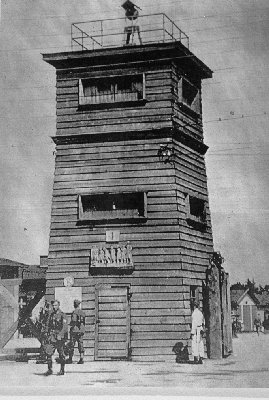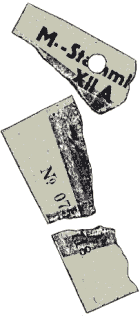

 |
 |
| Stalag VII A: Oral history |
|
Part I: We Arrive at Stalag VII
A Source: |
A Global Melting PotBy Robert D. ReevesPrisoners in Stalag VII-A were of many nationalities. The Germans tried to keep us segregated by country of origin in separate compounds surrounded by barbed wire. We did manage to communicate with men in adjoining yards, though, by a rudimentary form of sign language. 
On one side of us was a Russian contingent of prisoners that looked to us to be a perfect example of what we believed at the time was the stereotypical Russian soldier...muscle-bound and slow. They always outperformed the American GIs on our railroad rebuilding chores. Three or four Russians would lift heavy lengths of railroad track that required more than ten of us to get up. And, we always envied the warm clothing that the Russian soldiers wore. There was also a compound of soldiers from India near us. What intrigued us most about the Indians were their latrine customs. Where we always carried our own toilet paper with us, they carried none. What they took with them to the latrine was a coffee can filled with water in which they washed their soiled right hand after completing their chore. I'm told this method of personal hygiene is why a native of India is insulted by a right hand extended to shake hands. There were also many English and Canadian prisoners near us. These soldiers seemed more cocky and militant than we were. They were seldom seen marching out of step when they were moving as a group. I always felt sorry for the guys we called "political prisoners". They were encamped in nearby Dachau, but we were often in work details near them in Munich. They were dressed in the traditional black and white striped prison uniform we now recognize from the films taken of the horrors of the concentration camp at Dachau. Their shoes were made of wood soles with uppers of white canvas nailed around the sides, making it difficult to walk...impossible to run. The political prisoners were always begging us for food and cigarettes, but our guards would not allow us to give them any. We had no way of even guessing at the macabre reputation earned at Dachau that we now know as the Holocaust. All we could see was that these special enemies of Hitler's Germany were more mistreated than the rest of us. It is a mercy that we didn't know any more than we did. We were helpless in our own captivity, only miles away. Another Lesson Learned
Our forced labor within the prison walls was an exercise in drudgery and boredom. Even so, my one day of storing potatoes brought me another harrowing experience - and my second beating - at the hands of German guards. I was assigned to help bury potatoes in long, straw-filled ditches, then cover the trench with more straw and dirt. The ditches were right outside the stalag gate and yielded a supply that provided our meager potato rations. Not wanting to pass up the opportunity to fill my pockets with potatoes, I was discovered doing just that by a guard who unexpectedly stepped into sight. He delivered a severe thrashing to me with the bayonet scabbard hanging from his belt - a favorite weapon of the guards. After the beating, the man demanded to see my metallic prison identification tag that should have been issued to me back in October. By the time I received my ID number though, the Germans had run out of the metal tags, and I was issued one printed on cardboard. Not knowing that some of us had cardboard IDs, the guard angrily tore mine up and threw it on the ground. I was able to find three of the four pieces of the ID card, and I still have those three pieces that contain my German ID number, 075718. We stayed in the barracks on the north side of Main Street until just after Christmas of 1944. Then, as more prisoners arrived daily, we were moved out to a southern part of the camp. Unbelievably, this area was even worse than what we had become accustomed to, since the barracks were smaller, and actually more crowded. The new location also meant we had a much longer distance to walk to catch our train when we worked outside the stalag. By the time we moved into the back part of the camp, the routine of each day remained pretty much the same. I'll try to share the details of a typical day, while recollecting some of the more memorable events that took place in Stalag VII A.
|
| Last update 9 May 2001 by © WebTeam Moosburg (E-Mail) - All rights reserved! | |||